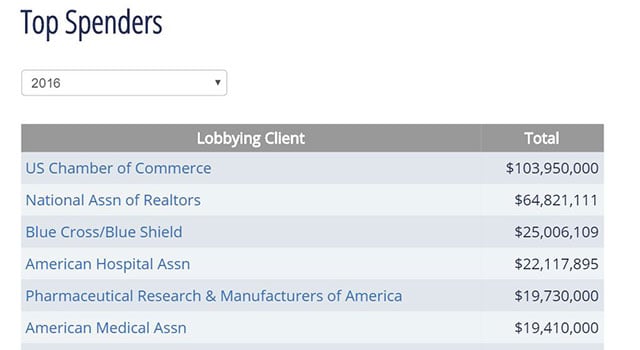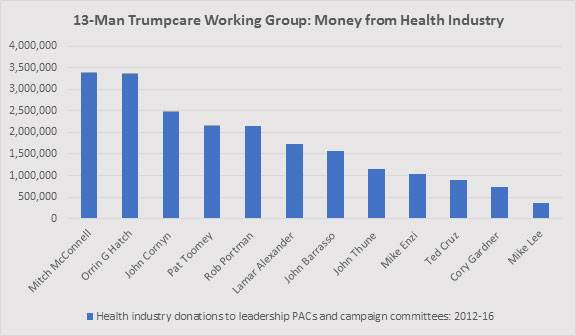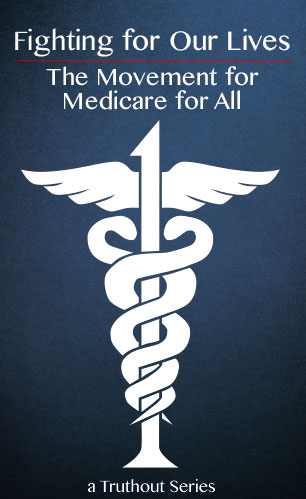
Part of the Series
Fighting for Our Lives: The Movement for Medicare for All
This piece is part of Fighting for Our Lives: The Movement for Medicare for All, a Truthout original series.
It has become fashionable to write premature obituaries of the Senate bill to “repeal and replace” the Affordable Care Act, using hyperbolic and misleading language. The Senate bill, according to varying headlines, is “in peril,” on “life support” and “dead on arrival.” These stories should be of little comfort given that the exact same headlines were published prior to the House passing its version of the repeal. That bill was also reportedly “on the verge of collapse,” “in tatters,” “flailing” and even “dead.”
Such sentiment could give Americans a false sense of complacency. There is still a real danger that this contemptible bill, which according to the Congressional Budget Office would lead to 22 million Americans becoming uninsured, will still become law. Considering this, stopping this legislation — which repeals Medicaid as much as it does the ACA — should remain the top short-term priority for advocates of health care justice.
But the fight to stop Trumpcare must also be part of a wider struggle for health care justice. The threat of this shameful legislation alone has demonstrated that it is morally indefensible to leave anyone without coverage. As a result, the argument for single-payer health care is starting to make sense to a lot of people, including a record number of Congress members and Sen. Elizabeth Warren, who publicly came out in favor of the policy in a Wall Street Journal article last week.
What Constituency Is Being Served in Washington?
Indeed, it is a testament to this growing support for single-payer that the New York Times devoted a front-page story to the issue in June. “The Single-payer Party? Democrats Shift Left on Health Care,” the headline read. But while a front-page story on momentum for Medicare for All is a welcome sight for advocates, the article amplifies a falsehood that reflects why the policy remains so elusive.
“Representative Nancy Pelosi of California, replied with a flat ‘no’ when asked if Democrats should make single-payer a central theme in 2018,” the Times reported. “The comfort level with the broader base of the American people is not there yet,” Pelosi said.
The House minority leader, however, is wrong. Polls show the public supports “Medicare for all,” and has for years. A recent Economist/YouGov poll, for instance, shows 60 percent support for the policy, including 75 percent of Democrats. Even a plurality of Republicans supports single payer: 46 percent support Medicare for All, compared with 38 percent opposed. (Seventeen percent are not sure.)
This begs the questions: If Medicare for All has popular support why do power brokers like Pelosi claim it isn’t viable? What constituency is not “comfortable” with a more efficient system that would provide universal health care? It is an especially relevant question now when we see Republicans go full bore trying to pass a bill that has only 12 percent support from the public, according to a USA Today poll.
The fact is that a very small and powerful group of rich people would be a little less rich if single-payer became a reality. “Insurance and pharmaceutical firms are the most important opponents of single payer,” said Dr. David Himmelstein, a founder of Physicians for a National Health Program, in an interview with Truthout. For-profit hospitals and manufacturers of medical devices oppose single-payer for the same reasons, he added.
These industries, and not the public, are the constituency who are not “comfortable,” with Medicare for All. This group might represent a very small number of people, but it is disproportionately powerful. In fact, according to data from the Center for Responsive Politics, Pelosi gets more money from health services than from any other industry — more than double the amount she receives from public-sector unions and investment firms combined:
 A screen shot of data from the Center for Responsive Politics shows the industries who spent the most in lobbying in 2016. Health-related industries accounted for four of the top six sectors. (Credit: Center for Responsive Politics)
A screen shot of data from the Center for Responsive Politics shows the industries who spent the most in lobbying in 2016. Health-related industries accounted for four of the top six sectors. (Credit: Center for Responsive Politics)
From a wider angle, the attack on single payer (and Medicaid for that matter) is, like so much of the neoliberal agenda, a form of class warfare that seeks to privatize and commodify almost everything. The goal is to add to the enormous fortunes of corporations and billionaires while, in the words of Eugene Debs, “millions of men and women who work all the days of their lives secure barely enough for a wretched existence.” These forces are emboldened by the ever-pervasive role of money in politics and enabled by the corporate-owned media establishment, which reliably serves elite interests.
Other enemies of single-payer include the American Medical Association (AMA), AARP, the Koch Brothers and the Chamber of Commerce. Even some ostensibly liberal advocacy groups, particularly those with industry funding, have also served as an obstacle to single-payer.
Understanding the nature of the opposition is a necessary, if daunting, step for advocates of health care justice to take on the road to making this reform a reality.
Single-Payer: An Existential Threat to the For-Profit Industry
The most significant enemies are health insurance and drug companies. “A single-payer reform would end insurers’ role in the health care system, essentially wiping out their entire business,” Himmelstein said.
The health sector spent more than $500 million on lobbying in 2016 and several billion in the last decade, according to the Center for Responsive Politics’ data. Lobbying from pharmaceutical firms accounts for almost half of the overall spending, totaling a little more than $245 million.
 (Chart: Michael Corcoran / Truthout; Data is from the Center for Responsive Politics)
(Chart: Michael Corcoran / Truthout; Data is from the Center for Responsive Politics)
“The [pharmaceutical] industry has never lacked for resources to amplify its voice in politics and policy making. Since 1999, pharmaceutical firms and health product companies have poured more money annually into lobbying than any other industry, including $229 million last year alone. PhRMA [Pharmaceutical Research and Manufacturers of America] led the group, plowing $16.6 million into helping advance drug makers’ priorities in Washington,” observed a report by the Center for Responsive Politics.
The insurance industry has even more at stake. American Health Insurance Plans (AHIP) is the primary lobby for health insurers. Russell Mokhiber of Single Payer Action once described the lobby as “public enemy number one,” and “the most aggressive opponent to single payer.”
“The health insurance corporations must die so that the American people can live,” he said.
Indeed, a true single-payer system would effectively abolish private health insurance as we know it. Therefore, the insurance lobby will always oppose any shift away from our system, which provides it with billions in profit every year. UnitedHealth Group, for instance, took in $185 billion in revenue in 2016, up $28 billion from 2015, according to its shareholder report released in January. The report “estimated revenues of $197 billion to $199 billion” in 2017.
AHIP has donated more than $250,000 to 100 Congress members in the current election cycle; 59 percent of that went to Republicans. The group has 36 registered lobbyists, and a startling 76 percent of them have been through the “revolving door,” according to the Center for Responsive Politics’ data: They formerly worked for the US government. Kyle Nevins, a lobbyist from Harbinger Strategies, spent “over a decade on Capitol Hill working with the House Republican Leadership.”
Another AHIP lobbyist, Aryana Khalid, worked for prominent Democrats until recently. She was chief of staff to the director of the Centers for Medicare and Medicaid (CMS) and a project director for the Affordable Care Act, and spent years working for Democrats. Her Twitter account is filled with support for the Affordable Care Act and critiques of Trump, but her day job is to help maximize profits for the nation’s biggest opponent of universal health care.
How the Industry Shapes the Debate
These industries have not been forced to actively lobby against a single-payer bill since none have come close to becoming law. Insurance and drug companies, however, have attacked single-payer successfully in other ways for years, using misinformation campaigns decrying the evils of “socialized medicine.” Wendell Potter, the former CIGNA executive who has turned into an advocate for health care justice, has described this sinister work from an insider’s point of view. He observed that a front group, Health Care America, founded largely by drug companies and maintained with the help of AHIP and the PR firm APCO Worldwide, existed “for the sole purpose of attacking” Michael Moore’s film Sicko — released 10 years ago this month.
AHIP’s planning documents for its strategy to counter Sicko’s influence are quite revelatory. They show an industry that greatly fears a blossoming movement for single-payer, cautioning lobbyists to “prepare for the worst.” The documents outline plans to ally with corporate/centrist groups like the Democratic Leadership Council and the Progressive Policy Institute, and to shape “media coverage to reflect the industry position” and highlight “horror stories” of government-run systems.
These industries have also spent decades smearing the Canadian health care system, which is universal, far less expensive and beloved by citizens of the country. “Over the course of a two-decade career as a health insurance executive, I spent hours and hours implementing my industry’s ongoing propaganda campaign to mislead people about the Canadian health care system,” Potter once said to a Canadian audience, noting he had yet to “encounter a single Canadian who didn’t talk about their Medicare program with pride.”
These campaigns to spread falsehoods about government-run health care have been quite effective. As of this writing, searching for “Canada” and “health care” via Google, pulls up numerous attacks about the “ugly truth” of the Canadian system and articles that describe Canada’s embrace of universal health care as a “cautionary tale.”
Fairness and Accuracy in Reporting (FAIR) has documented for years how the corporate media has been dismissive of single-payer — when they give it any attention at all. That bias continues to this day. The Times’s front page article on June 3 cited a poll saying there is only “40 percent” support for single-payer, even though when the language “Medicare for All” is used, support is near or above 60 percent. There was no mention of these polls, or other polls showing that the insurance industry is no longer succeeding in making “single-payer” into a pejorative term.
The dominant media, however, have played right into the industry’s hands. AHIP’s president was given space in USA Today to advance the industry narrative after Sicko was released. CNN famously ran a smear job by Dr. Sanjay Gupta, which Gupta later begrudgingly confessed contained provable falsehoods. The response from Washington Post staff writer Stephen Hunter to Moore was similar to the most common (and spurious) straw man attacks against Bernie Sanders: that the left thinks health care can be “free.” In reality, single-payer health care is not free, it is simply paid for by taxes rather than by co-pays, premiums, and so on.
This attack was used not only by the usual suspects, but also by some self-identified progressives. This is also an obstacle to single-payer. Some liberal groups like Health Care for America Now, the Center for American Progress, and the Urban Institute, have not come out in support of single-payer and sometimes attack it. They also tend to cut it out of the conversation entirely. For instance, a search of the website for Health Care for America Now for the term “single payer” yields zero results. These groups narrow the parameters of debate to the exclusion of the most humane and efficient solution.
Single-Payer as Class Warfare
Opponents of single-payer, as noted above, are not merely those in the health sector. By and large, the top 1 percent of the population — the billionaire class, as Sanders would call it — embraces privatization of most things, including health care.
A Center for Public Integrity (CPI) analysis of Senate lobbying disclosure forms from 2010 “shows that more than 1,750 companies and organizations hired about 4,525 lobbyists — eight for each member of Congress — to influence health reform bills in 2009.”
The industry’s money did not go to waste.
“A close look at the health reform bills that passed the House and Senate show lobbyists were apparently effective at blocking provisions like a robust government-run insurance program,” the CPI analysis observed.
But the health industry was not the only powerful player working to quash single payer. The US Chamber of Commerce, for instance, was hiring lobbyists to shape the federal reform. They were also active in successfully opposing state-wide single-payer efforts in Colorado and Vermont. Koch-funded groups like Americans for Prosperity, the Independence Institute and the Ethan Allen Institute also contributed to the battle to halt momentum for Medicare for All. More recently a bill in California for a state-wide single-payer died in the State Assembly on June 23. The Chamber has been attacking the bill as a “job killer” before the Democrats pulled the legislation back.
The Koch brothers aren’t even active in the for-profit health industry; they deal largely in energy. But pushing back against single-payer is aligned with their wider goal: shrinking government as much as possible.
“If single payer ever took off anywhere, it could threaten their anti-government messages,” Mary Bottari, of the Center for Media and Democracy, told Truthout in a previous interview about the Kochs’ activities on health policy.
Single Payer and the Fight for Social Democracy
In this sense, we see how single payer is not merely a threat to the insurance industry; it is also a boon to democracy. Its passage would threaten part of the top 1 percent of Americans — the constituents politicians care most about. Their ability to keep that level of influence is threatened if the public can enforce its will and win single-payer, either in a state or nationally.
This is one of many reasons why the battle for single-payer is about much more than health care policy. How a nation treats its sick people says something about the country’s ability to have a functioning social democracy. Winning this battle against single-payer’s powerful enemies would not only be good for the health of the nation; it would serve as an enormous victory for the movement for social justice more broadly.
Our most important fundraising appeal of the year
December is the most critical time of year for Truthout, because our nonprofit news is funded almost entirely by individual donations from readers like you. So before you navigate away, we ask that you take just a second to support Truthout with a tax-deductible donation.
This year is a little different. We are up against a far-reaching, wide-scale attack on press freedom coming from the Trump administration. 2025 was a year of frightening censorship, news industry corporate consolidation, and worsening financial conditions for progressive nonprofits across the board.
We can only resist Trump’s agenda by cultivating a strong base of support. The right-wing mediasphere is funded comfortably by billionaire owners and venture capitalist philanthropists. At Truthout, we have you.
We’ve set an ambitious target for our year-end campaign — a goal of $250,000 to keep up our fight against authoritarianism in 2026. Please take a meaningful action in this fight: make a one-time or monthly donation to Truthout before December 31. If you have the means, please dig deep.
